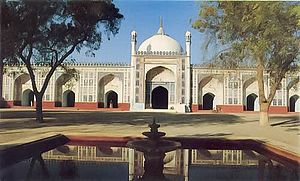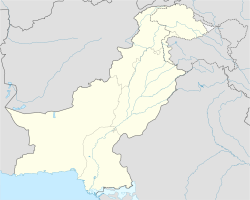Shahi Eid Gah Mosque
| Shahi Eid Gah Mosque | |
|---|---|

The Shahi Eid Gah Mosque dates from the late Mughal period.
|
|
| Basic information | |
| Location |
Pakistan |
| Geographic coordinates | 30°12′39″N 71°28′44″E / 30.2107936°N 71.4789388°ECoordinates: 30°12′39″N 71°28′44″E / 30.2107936°N 71.4789388°E |
| Affiliation | Islam |
| Ecclesiastical or organizational status | Mosque |
| Architectural description | |
| Architectural type | Mosque |
| Architectural style | Indo-Islamic/Mughal |
| Completed | 1735 |
| Dome(s) | 7 |
The Shahi Eid Gah Mosque (Punjabi/Urdu: شاہی عید گاہ مسجد ) is an early 18th-century mosque located in the Pakistani city of Multan, in southern Punjab.
located on the main Multan-Lahore highway in the Northeast of the oldest part of the city. The mosque is adjacent to the 20th century Sufi shrine of Ahmad Saeed Kazmi.
The mosque was built in 1735 AD by Khokhar family and Nawab Abdul Samad Khan and when he was the Mughal governor of Multan. After independence it was found insufficient to accommodate the increased number of people so its courtyard was enlarged further.
The mosque is spacious, with a vast courtyard and a prayer chamber measuring 250 feet by 55 feet. The mosque has seven domes.
The mosque's exterior is embellished with glazed blue Multan-style tiles, while the interior is ornamented with intricate mosaics.
The Shahi Eid Gah Mosque is decorated with elaborate and intricate Mughal-era frescoes.]]
...
Wikipedia

